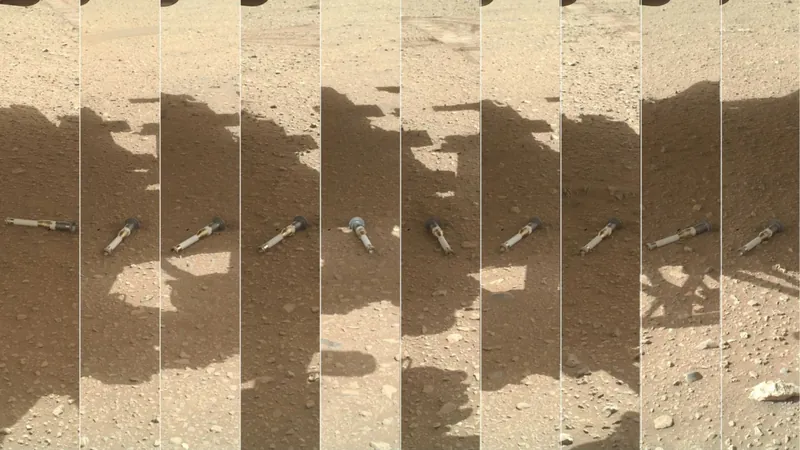
NASA Delays Mars Sample Return Decision Until 2026: What’s at Stake?
2025-01-08
Author: Rajesh
NASA's Ambitious Plans
NASA has ambitious plans to bring rock and soil samples from the surface of Mars back to Earth, aiming for a groundbreaking mission in the 2030s. This historic mission would mark the first time any scientific samples from another planet are returned home, offering a treasure trove of data for researchers studying planetary evolution and the potential for life beyond Earth. However, the space agency announced that it requires another year to finalize its plans for Mars Sample Return, pushing a decision to at least mid-2026.
Current Status of Mars Sample Return Program
During a press briefing, NASA Administrator Bill Nelson and Nicky Fox, the associate administrator for the Science Mission Directorate, outlined the current state of the Mars Sample Return program. A major discussion point is the choice between two 'landing architectures' for the mission: one leveraging NASA's proven methods and the other exploring partnerships with commercial aerospace companies.
Collaboration and Achievements
The Mars Sample Return initiative is a collaboration between NASA and the European Space Agency (ESA), and has already secured 28 titanium-sealed tubes that house samples collected by the Perseverance rover from Jezero Crater. This mission is not only poised to demonstrate the first round trip to another planet but will also be the first instance in history where multiple spacecraft have landed on Mars simultaneously.
Significance of the Mission
Fox emphasized the mission's significance, stating, 'It’s humanity’s first mission to bring scientific samples from any planet right back here to Earth for study using our state of the art facilities.' These samples will inform future astronaut missions and broaden our understanding of both Mars’s environment and the early conditions of Earth.
Budget and Timeline Challenges
However, the project is under pressure due to its ballooning budget, which has reportedly exceeded $6 billion, leading to forecasts that samples may not be returned until the 2040s. Nelson described this timeline as 'unacceptable' and has urged Congress to allocate at least $300 million for the mission in the fiscal year 2025 to expedite its progress.
Cost Evaluation of Options
NASA is now weighing costs between two main options. The 'Sky Crane' method, which has successfully landed the Perseverance and Curiosity rovers, would cost between $6.6 billion and $7.7 billion. In contrast, the secondary option, potentially involving commercial partners like SpaceX and Blue Origin, is expected to range from $5.8 billion to $7.1 billion. Both strategies involve redesigning the landing platform to ensure successful retrieval of samples.
Future Prospects
Presently, the team is confident that with these refined approaches, we could see Martian samples retrieved as early as 2035, if the funding and planning align correctly. The earliest ESA’s Earth Return Orbiter could launch to retrieve the Martian samples is set for 2030, followed by the sample return lander potentially taking off the subsequent year.
Conclusion and Call for Support
Ultimately, the future of this groundbreaking endeavor hinges on the decisions made in the next year and the available funding set forth by Congress. As Nelson put it, 'If they want to get this thing back on a direct return earlier, they’re going to have to put more money into it, even more than $300 million in fiscal year 2025.' The next stages are crucial, and whether the mission will proceed as planned could depend on both technical evaluations and political support. The excitement grows as humanity prepares for a new chapter in our exploration of Mars. Will we soon unlock the secrets of the Red Planet? Only time—and funding—will tell.


 Brasil (PT)
Brasil (PT)
 Canada (EN)
Canada (EN)
 Chile (ES)
Chile (ES)
 Česko (CS)
Česko (CS)
 대한민국 (KO)
대한민국 (KO)
 España (ES)
España (ES)
 France (FR)
France (FR)
 Hong Kong (EN)
Hong Kong (EN)
 Italia (IT)
Italia (IT)
 日本 (JA)
日本 (JA)
 Magyarország (HU)
Magyarország (HU)
 Norge (NO)
Norge (NO)
 Polska (PL)
Polska (PL)
 Schweiz (DE)
Schweiz (DE)
 Singapore (EN)
Singapore (EN)
 Sverige (SV)
Sverige (SV)
 Suomi (FI)
Suomi (FI)
 Türkiye (TR)
Türkiye (TR)
 الإمارات العربية المتحدة (AR)
الإمارات العربية المتحدة (AR)